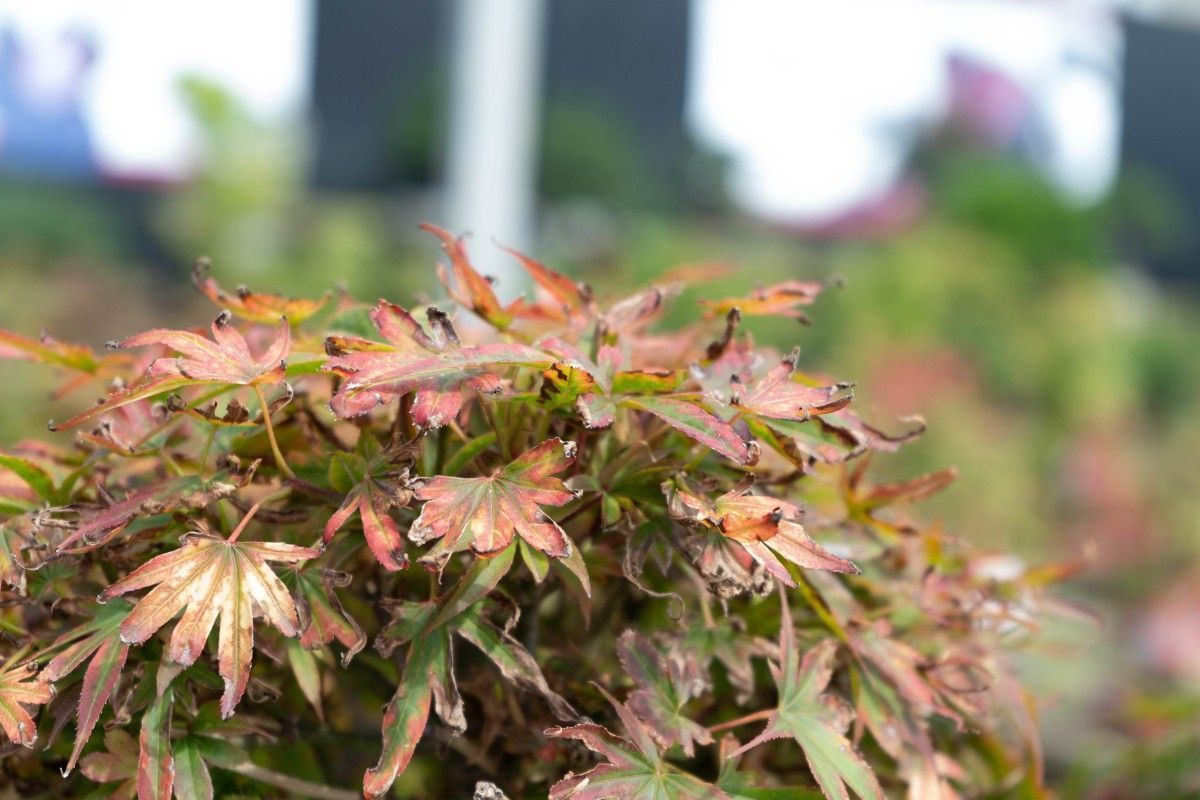My Acer’s leaves have scorched, what do I do?

Summer has arrived and the tips of the Acer’s leaves are scorched. Why did this happen? What should I do? Should I cut them? In this post we explain what you should do when this happens.
Why do Acers leaves scorch?
During very hot temperatures in summer, our bonsai have a defence mechanism against the heat. Before losing all the water, they sacrifice parts of the leaves in a process that has to do with plant transpiration.
Plant transpiration consists of the loss of water in the form of vapor that occurs in plants. In other words, the leaves then close their stomata to prevent water loss. As it is very hot, the stomata remain closed and therefore the edges of the leaves, not being able to regulate the passage of water into the environment, get scorched. Notice that it goes from the tips to the center of the leaf.
What can I do to prevent it?
We are giving you a series of tips to protect your bonsai Acer’s leaves in summer and avoid the leaves of the acers from getting scorched:
- Verify the need for watering daily and up to 2 times a day.
- Create a humid environment. Fill the dishes under the pots with water. When it evaporates, it will favour a more humid environment. Beware of puddling of the roots.
- Protect your bonsai from the sun. Prevent the sun’s rays from directly hitting your bonsai.
- Move the pots away from the walls and the ground, to prevent the refraction of sun beams from generating more heat in the pot.
To sum up, these measures can help reduce the number of leaves that scorch from the intense heat.
But what if some leaves are still scorch?
What to do with the scorched leaves of my bonsai?
Acers are used to the climate of Japan, so some leaves are inevitably going to scorch. But your bonsai is not going to die from it. This process is a natural defence of the tree against intense heat.
You would love to cut them, right? Although at first it may seem like the solution, we do not recommend it. If you cut them, the natural process of bud growth and development will begin again. Most important, we must remember that after summer comes autumn. In autumn, trees store energy to get through the winter. But if the tree spends this energy with the growth of the leaves, then in winter the tree will have no reserves.
The best option is to let the tree to get rid of scorched leaves whenever is best for it. This process is the most natural. In autumn the fall of the leaves will put an end to the summer season, and the buds will not grow because the cold of winter will keep them dormant (asleep). It will sprout strongly next spring.
Likewise, we also don’t have to trim the burned edge of the sheet. Remember that the tree has done it for protection. If you cut it back, you will force the plant to go through the stomatal closing process again and the new edge of the leaf will dry out again. This greatly weakens the energy of the plant.
We simply let the plant be the one to remove the leaf when it is ready.
In this season we specially need to think about “Muchigomi”. Muchigomi means the accompaniment that the bonsai carer gives to his bonsai every day. It means walking together this wonderful path of bonsai. Holding hands with your tree.
In conclusion, enjoy the sun, check your trees daily and let yourself wonder with what our bonsai offer us in each season.
Until next time. I have to go, I must go water my bonsai…
About the Author
Luis Alejandro Herrera
Spreading the art of bonsai is his passion. As a reference in the Latin American bonsai world, Luis studied and participated as an instructor for more than 15 years within the Venezuelan Bonsai Society. He had the opportunity to expand his knowledge with great masters from the world of bonsai like Pedro Morales, Nacho Marín; and within the European school with the Italian teacher Salvatore Liporace. He managed to be in the first place of the Caracas 2016 New Talents Contest and successfully completed the master class of the European School of Bonsai in Puerto Rico. During his career he has been a permanent instructor of the Venezuelan Society of Bonsai.
Categories
Bonsai cultivation and care (54)
Bonsai gift (2)
Bonsai pests and diseases (6)
Bonsai repotting (3)
bonsai substrates (2)
bonsai tools (1)
Bonsai work (10)
Ceramic pots (3)
Chinese culture (2)
Chinese culture (1)
Corporative Mistral Bonsai (8)
Cuidados del bonsái (22)
Cultivo del bonsái (20)
Dead wood (2)
